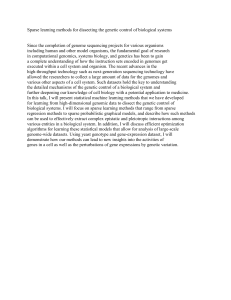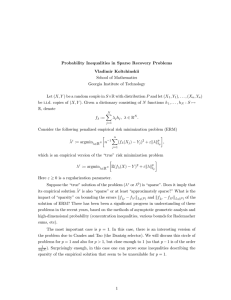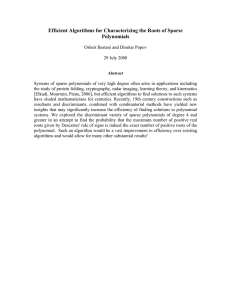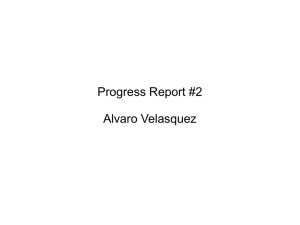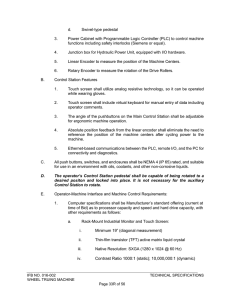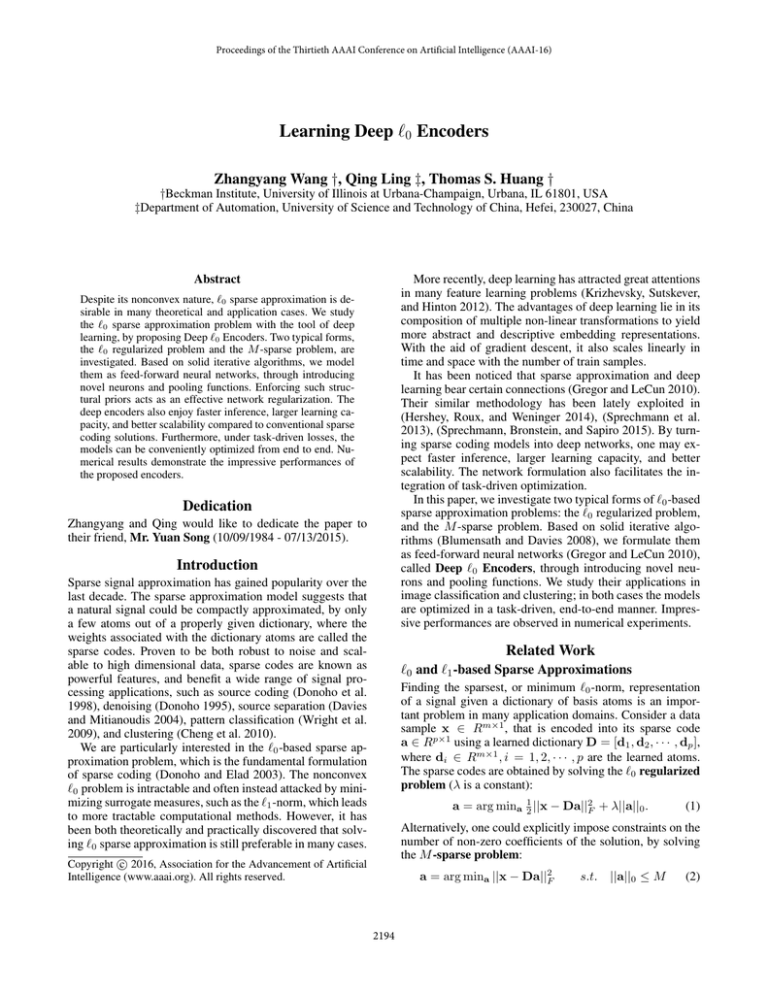
Proceedings of the Thirtieth AAAI Conference on Artificial Intelligence (AAAI-16)
Learning Deep 0 Encoders
Zhangyang Wang †, Qing Ling ‡, Thomas S. Huang †
†Beckman Institute, University of Illinois at Urbana-Champaign, Urbana, IL 61801, USA
‡Department of Automation, University of Science and Technology of China, Hefei, 230027, China
More recently, deep learning has attracted great attentions
in many feature learning problems (Krizhevsky, Sutskever,
and Hinton 2012). The advantages of deep learning lie in its
composition of multiple non-linear transformations to yield
more abstract and descriptive embedding representations.
With the aid of gradient descent, it also scales linearly in
time and space with the number of train samples.
It has been noticed that sparse approximation and deep
learning bear certain connections (Gregor and LeCun 2010).
Their similar methodology has been lately exploited in
(Hershey, Roux, and Weninger 2014), (Sprechmann et al.
2013), (Sprechmann, Bronstein, and Sapiro 2015). By turning sparse coding models into deep networks, one may expect faster inference, larger learning capacity, and better
scalability. The network formulation also facilitates the integration of task-driven optimization.
In this paper, we investigate two typical forms of 0 -based
sparse approximation problems: the 0 regularized problem,
and the M -sparse problem. Based on solid iterative algorithms (Blumensath and Davies 2008), we formulate them
as feed-forward neural networks (Gregor and LeCun 2010),
called Deep 0 Encoders, through introducing novel neurons and pooling functions. We study their applications in
image classification and clustering; in both cases the models
are optimized in a task-driven, end-to-end manner. Impressive performances are observed in numerical experiments.
Abstract
Despite its nonconvex nature, 0 sparse approximation is desirable in many theoretical and application cases. We study
the 0 sparse approximation problem with the tool of deep
learning, by proposing Deep 0 Encoders. Two typical forms,
the 0 regularized problem and the M -sparse problem, are
investigated. Based on solid iterative algorithms, we model
them as feed-forward neural networks, through introducing
novel neurons and pooling functions. Enforcing such structural priors acts as an effective network regularization. The
deep encoders also enjoy faster inference, larger learning capacity, and better scalability compared to conventional sparse
coding solutions. Furthermore, under task-driven losses, the
models can be conveniently optimized from end to end. Numerical results demonstrate the impressive performances of
the proposed encoders.
Dedication
Zhangyang and Qing would like to dedicate the paper to
their friend, Mr. Yuan Song (10/09/1984 - 07/13/2015).
Introduction
Sparse signal approximation has gained popularity over the
last decade. The sparse approximation model suggests that
a natural signal could be compactly approximated, by only
a few atoms out of a properly given dictionary, where the
weights associated with the dictionary atoms are called the
sparse codes. Proven to be both robust to noise and scalable to high dimensional data, sparse codes are known as
powerful features, and benefit a wide range of signal processing applications, such as source coding (Donoho et al.
1998), denoising (Donoho 1995), source separation (Davies
and Mitianoudis 2004), pattern classification (Wright et al.
2009), and clustering (Cheng et al. 2010).
We are particularly interested in the 0 -based sparse approximation problem, which is the fundamental formulation
of sparse coding (Donoho and Elad 2003). The nonconvex
0 problem is intractable and often instead attacked by minimizing surrogate measures, such as the 1 -norm, which leads
to more tractable computational methods. However, it has
been both theoretically and practically discovered that solving 0 sparse approximation is still preferable in many cases.
Related Work
0 and 1 -based Sparse Approximations
Finding the sparsest, or minimum 0 -norm, representation
of a signal given a dictionary of basis atoms is an important problem in many application domains. Consider a data
sample x ∈ Rm×1 , that is encoded into its sparse code
a ∈ Rp×1 using a learned dictionary D = [d1 , d2 , · · · , dp ],
where di ∈ Rm×1 , i = 1, 2, · · · , p are the learned atoms.
The sparse codes are obtained by solving the 0 regularized
problem (λ is a constant):
a = arg mina 12 ||x − Da||2F + λ||a||0 .
(1)
Alternatively, one could explicitly impose constraints on the
number of non-zero coefficients of the solution, by solving
the M -sparse problem:
c 2016, Association for the Advancement of Artificial
Copyright Intelligence (www.aaai.org). All rights reserved.
a = arg mina ||x − Da||2F
2194
s.t.
||a||0 ≤ M
(2)
zk (k = 1, 2) according to
Unfortunately, these optimization problems are often intractable because there is a combinatorial increase in the
number of local minima as the number of the candidate basis
vectors increases. One potential remedy is to employ a convex surrogate measure, such as the 1 -norm, in place of the
0 -norm that leads to a more tractable optimization problem.
For example, (1) could be relaxed as:
a = arg mina 12 ||x − Da||2F + λ||a||1 .
zk+1 = sθ (Wx + Szk ),
(4)
where sθ is an element-wise shrinkage function (u is a vector and ui is its i-th element, i = 1, 2, ..., p):
[sθ (u)]i = sign(ui )(|ui | − θi )+ .
(5)
The parameterized encoder, named learned ISTA (LISTA),
is a natural network implementation of the iterative shrinkage and thresholding algorithm (ISTA). LISTA learned all
its parameters W, S and θ from training data using a backpropagation algorithm (LeCun et al. 2012). In this way, a
good approximation of the underlying sparse code can be
obtained after a fixed small number of stages.
In (Sprechmann et al. 2013), the authors leveraged a
similar idea on fast trainable regressors and constructed
feed-forward network approximations of the learned sparse
models. Such a process-centric view was later extended in
(Sprechmann, Bronstein, and Sapiro 2015) to develop a
principled process of learned deterministic fixed-complexity
pursuits, in lieu of iterative proximal gradient descent algorithms, for structured sparse and robust low rank models. Very recently, (Hershey, Roux, and Weninger 2014) further summarized the methodology of the problem-level and
model-based “deep unfolding”, and developed new architectures as inference algorithms for both Markov random fields
and non-negative matrix factorization. Our work shares the
similar spirit with those prior wisdoms, yet studies the unexplored 0 problems with further insights obtained.
(3)
It creates a unimodal optimization problem that can be
solved via linear programming techniques. The downside is
that we have now introduced a mismatch between the ultimate goal and the objective function (Wipf and Rao 2004).
Under certain conditions, the minimum 1 -norm solution
equals to the minimum 0 -norm one (Donoho and Elad
2003). But in practice, the 1 approximation is often used
way beyond these conditions, and is thus quite heuristic. As
a result, we often get a solution which is not exactly minimizing the original 0 -norm.
That said, 1 approximation is found to work practically
well for many sparse coding problems. Yet in certain applications, we intend to control the exact number of nonzero
elements, such as basis selection (Wipf and Rao 2004),
where 0 approximation is indispensable. Beyond that, 0 approximation are desirable for performance concerns in
many ways. In compressive sensing literature, empirical evidence (Candes, Wakin, and Boyd 2008) suggested that using
an iterative reweighted 1 scheme to approximate the 0 solution often improved the quality of signal recovery. In image enhancement, it was shown in (Yuan and Ghanem 2015)
that 0 data fidelity was more suitable for reconstructing images corrupted with impulse noise. For the purpose of image
smoothening, the authors of (Xu et al. 2011) utilized 0 gradient minimization to globally control how many non-zero
gradients to approximate prominent structures in a structuresparsity-management manner. Recent work (Wang, Wang,
and Singh 2015) revealed that 0 sparse subspace clustering can completely characterize the set of minimal union-ofsubspace structure, without additional separation conditions
required by its 1 counterpart.
Deep 0 Encoders
Deep 0 -Regularized Encoder
To solve the optimization problem in (1), an iterative hardthresholding (IHT) algorithm was derived in (Blumensath
and Davies 2008):
k
ak+1 = hλ0.5 (ak + DT (x − Da )),
(6)
where ak denotes the intermediate result of the k-th iteration, and hθ is an element-wise hard thresholding operator:
0
if |ui | < λ0.5
[hλ0.5 (u)]i =
(7)
ui
if |ui | ≥ λ0.5
Network Implementation of 1 -Approximation
Figure 2: The block diagram of solving (6).
.
Figure 1: A LISTA network (Gregor and LeCun 2010) with
two time-unfolded stages.
Eqn. (6) could be alternatively rewritten as:
In (Gregor and LeCun 2010), a feed-forward neural network, as illustrated in Fig. 1, was proposed to efficiently approximate the 1 -based sparse code a of the input signal x;
the sparse code a is obtained by solving (3) for a given dictionary D in advance. The network has a finite number of
stages, each of which updates the intermediate sparse code
ak+1 = hθ (Wx + Sak ),
W = DT , S = I − DT D, θ = λ0.5 ,
(8)
and expressed as the block diagram in Fig. 2, which outlines
a recurrent network form of solving (6).
2195
Figure 3: Deep 0 -Regularized Encoder, with two time-unfolded stages.
Figure 4: Deep M -sparse Encoder, with two time-unfolded stages.
By time-unfolding and truncating Fig. 2 to a fixed number
of K iterations (K = 2 in this paper by default)1 , we obtain a
feed-forward network structure in Fig. 3, where W, S and θ
are shared among both stages, named Deep 0 -Regularized
Encoder, Furthermore, W, S and θ are all to be learnt, instead of being directly constructed from any pre-computed
D. Although the equations in (8) do not directly apply any
more to solving the Deep 0 -Regularized Encoder, they can
usually serve as a high-quality initialization of the latter.
Note that the activation thresholds θ are less straightforward to update. We rewrite (5) as: [hθ (u)]i = θi h1 (ui /θi ).
It indicates that the original neuron with trainable thresholds can be decomposed into two linear scaling layers, plus
a unit-hard-threshold neuron, the latter of which is called
Hard thrEsholding Linear Unit (HELU) by us. The weights
of the two scaling layers are diagonal matrices defined by θ
and its element-wise reciprocal, respectively.
Discussion on HELU While being inspired by LISTA, the
differentiating point of Deep 0 -Regularized Encoder lies in
the HELU neuron. Compared to classical neuron functions
such as logistic, sigmoid, and ReLU (Mhaskar and Micchelli
1994), as well as the soft shrinkage and thresholding operation (5) in LISTA, HELU does not penalize large values, yet
enforces strong (in theory infinite) penalty over small values.
As such, HELU tends to produce highly sparse solutions.
The neuron form of LISTA (5) could be viewed as a
double-sided and translated variant of ReLU, which is continuous and piecewise linear. In contrast, HELU is a discontinuous function that rarely occurs in existing deep network neurons. As pointed out by (Hornik, Stinchcombe, and
White 1989), HELU has countably many discontinuities and
is thus (Borel) measurable, in which case the universal approximation capability of the network is not compromised.
However, experiments remind us that the algorithmic learn-
ability with such discontinuous neurons (using popular firstorder methods) is in question, and the training is in general
hard. For computation concerns, we replace HELU with the
following continuous and piecewise linear function HELUσ ,
during network training:
⎧
0
if |ui | ≤ 1 − σ
⎪
⎪
⎨ (ui −1+σ)
if
1 − σ < ui < 1
σ
[HELUσ (u)]i =
(ui +1−σ)
⎪
if − 1 < ui < σ − 1
⎪
σ
⎩
if |ui | ≥ 1
ui
(9)
Obviously, HELUσ becomes HELU when σ → 0. To approximate HELU, we tend to choose very small σ, while
avoiding putting the training ill-posed. As a practical strategy, we start with a moderate σ (0.2 by default), and divide it
by 10 after each epoch. After several epoches, HELUσ turns
very close to the ideal HELU.
In (Rozell et al. 2008), the authors introduced an ideal
hard thresholding function for solving sparse coding, whose
formulation was close to HELU. Note that (Rozell et al.
2008) approximates the ideal function with a sigmoid function, which has connections with our HELUσ approximation. In (Konda, Memisevic, and Krueger 2014), a similar
truncated linear ReLU was utilized in the networks.
Deep M-Sparse 0 Encoder
Both the 0 regularized problem in (1) and Deep 0 Regularized Encoder have no explicit control on the sparsity level of the solution. One would therefore turn to the
M -sparse problem in (2), and derive the following iterative
algorithm (Blumensath and Davies 2008):
k
ak+1 = hM (ak + DT (x − Da )).
(10)
Eqn. (10) resembles (6), except that hM is now a nonlinear operator retaining the M coefficients with the top M largest absolute values. Following the same methodology
We test larger K values (3 or 4). In several cases they do bring
performance improvements, but add complexity too..
1
2196
as in the previous section, the iterative form could be timeunfolded and truncated to the Deep M -sparse Encoder, as
in Fig. 4. To deal with the hM operation, we refer to the popular concepts of pooling and unpooling (Zeiler, Taylor, and
Fergus 2011) in deep networks, and introduce the pairs of
maxM pooling and unpooling, in Fig. 4.
Discussion on maxM pooling/unpooling Pooling is popular in convolutional networks to obtain translation-invariant
features (Krizhevsky, Sutskever, and Hinton 2012). It is yet
less common in other forms of deep networks (Gulcehre
et al. 2014). The unpooling operation was introduced in
(Zeiler, Taylor, and Fergus 2011) to insert the pooled values
back to the appropriate locations of feature maps for reconstruction purposes.
In our proposed Deep M -sparse Encoder, the pooling and
unpooling operation pair is used to construct a projection
from Rm to its subset S : {s ∈ Rm |||s||0 ≤ M }. The maxM
pooling and unpooling functions are intuitively defined as:
[pM , idxM ] = maxM .pooling(u)
uM = maxM .unpooling(pM , idxM )
by adding discriminable regularization terms to the objective. Recent work (Mairal, Bach, and Ponce 2012), (Wang
et al. 2015a) developed task-driven sparse coding via bilevel optimization models, where (1 -based) sparse coding
is formulated as the lower-level constraint while a taskoriented cost function is minimized as its upper-level objective. The above approaches in sparse coding are complicated
and computationally expensive. It is much more convenient
to implement end-to-end task-driven training in deep architectures, by concatenating the proposed deep encoders with
certain task-driven loss functions.
In this paper, we mainly discuss two tasks: classification and clustering, while being aware of other immediate
extensions, such as semi-supervised learning. Assuming K
classes (or clusters), and ω = [ω1 , ..., ω k ] as the set of parameters of the loss function, where ωi corresponds to the jth class (cluster), j = 1, 2, ..., K. For the classification case,
one natural choice is the well-known softmax loss function.
For the clustering case, since the true cluster label of each x
is unknown, we define the predicted confidence probability
pj that sample x belongs to cluster j, as the likelihood of
softmax regression:
(11)
For each input u, the pooled map pM records the top M largest values (irrespective of sign), and the switch idxM
records their locations. The corresponding unpooling operation takes the elements in pM and places them in uM at the
locations specified by idxM , the remaining elements being
set to zero. The resulting uM is of the same dimension as u
but has exactly no more than M non-zero elements. In back
propagation, each position in idxM is propagated with the
entire error signal.
pj = p(j|ω, a) =
e
K
Ta
−ωj
l=1
Ta
e−ωl
.
(12)
The predicted cluster label of a is the cluster j where it
achieves the largest pj .
Experiment
Implementation
Two proposed deep 0 encoders are implemented with the
CUDA ConvNet package (Krizhevsky, Sutskever, and Hinton 2012). We use a constant learning rate of 0.01 with
no momentum, and a batch size of 128. In practice, given
that the model is well initialized, the training takes approximately 1 hour on the MNIST dataset, on a workstation with
12 Intel Xeon 2.67GHz CPUs and 1 GTX680 GPU. It is also
observed that the training efficiency of our model scales approximately linearly with the size of data.
While many neural networks train well with random initializations without pre-training, given that the training data
is sufficient, it has been discovered that poorly initialized
networks can hamper the effectiveness of first-order methods (e.g., SGD) (Sutskever et al. 2013). For the proposed
models, it is however much easier to initialize the model in
the right regime, benefiting from the analytical relationships
between sparse coding and network hyperparameters in (8).
Theoretical Properties
It is showed in (Blumensath and Davies 2008) that the iterative algorithms in both (6) and (10) are guaranteed not to
increase the cost functions. Under mild conditions, their targeted fixed points are local minima of the original problems.
As the next step after the time truncation, the deep encoder
models are to be solved by the stochastic gradient descent
(SGD) algorithm, which converges to stationary points under a few stricter assumptions than ones satisfied in this paper (Bottou 2010) 2 . However, the entanglement of the iterative algorithms and the SGD algorithm makes the overall
convergence analysis a serious hardship.
One must emphasize that in each step, the back propagation procedure requires only operations of order O(p) (Gregor and LeCun 2010). The training algorithm takes O(Cnp)
time (C is the constant absorbing epochs, stage numbers,
etc). The testing process is purely feed-forward and is therefore dramatically faster than traditional inference methods
by solving (1) or (2). SGD is also easy to be parallelized.
Simulation on 0 Sparse Approximation
We first compare the performance of different methods on
0 sparse code approximation. The first 60,000 samples of
the MNIST dataset are used for training and the last 10,000
for testing. Each patch is resized to 16 × 16 and then preprocessed to remove its mean and normalize its variance.
The patches with small standard deviations are discarded.
A sparsity coefficient λ = 0.5 is used in (1), and the sparsity level M = 32 is fixed in (2). The sparse code dimension
(dictionary size) p is to be varied.
Task-Driven Optimization
It is often desirable to jointly optimize the learned sparse
code features and the targeted task so that they mutually
reinforce each other. The authors of (Jiang, Lin, and Davis
2011) associated label information with each dictionary item
2
As a typical case, we use SGD in a setting where it is not guaranteed to converge in theory, but behaves well in practice.
2197
coders, with the probabilities of retaining the units being 0.9,
0.9, and 0.5. The proposed encoders do not apply dropout.
The deep 0 encoders and the baseline encoder are first
trained, and all are then evaluated on the testing set. We calculate the total prediction errors, i.e., the normalized squared
errors between the optimal codes and the predicted codes, as
in Tables 1 and 2. For the M -sparse case, we also compare
their recovery of non-zero supports in Table 3, by counting
the mismatched nonzero element locations between optimal
and predicted codes (averaged on all samples). Immediate
conclusions from the numerical results are as follows:
Table 1: Prediction error (%) comparison of all methods on
solving the 0 -regularized problem (1)
p
128
256
512
Iterative (2 iterations)
17.52 18.73 22.40
Iterative (5 iterations)
8.14
6.75
9.37
Iterative (10 iterations)
3.55
4.33
4.08
Baseline Encoder
8.94
8.76 10.17
Deep 0 -Regularized Encoder 0.92
0.91
0.81
Our prediction task resembles the setup in (Gregor and
LeCun 2010): first learning a dictionary from training data,
following by solving sparse approximation (3) with respect
to the dictionary, and finally training the network as a regressor from input samples to the solved sparse codes. The
only major difference here lies in that unlike the 1 -based
problems, the non-convex 0 -based minimization could only
reach a (non-unique) local minimum. To improve stability,
we first solve the 1 problems to obtain a good initialization for 0 problems, and then run the iterative algorithms
(6) or (10) until convergence. The obtained sparse codes are
called “optimal codes” hereinafter and used in both training
and testing evaluation (as “groundtruth”). One must keep in
mind that we are not seeking to produce approximate sparse
code for all possible input vectors, but only for input vectors
drawn from the same distribution as our training samples.
• The proposed deep encoders have outstanding generalization performances, thanks to the effective regularization
brought by their architectures, which are derived from
specific problem formulations (i.e., (1) and (2)) as priors.
The “general-architecture” baseline encoders, which have
the same parameter complexity, appear to overfit the training set and generalize much worse.
Table 2: Prediction error (%) comparison of all methods on
solving the M -sparse problem (2)
p
128
256
512
Iterative (2 iterations)
17.23 19.27 19.31
Iterative (5 iterations)
10.84 12.52 12.40
Iterative (10 iterations)
5.67
5.44
5.20
Baseline Encoder
14.04 16.76 12.86
Deep M -Sparse Encoder 2.94
2.87
3.29
• The Deep M -Sparse Encoder is able to find the nonzero
support with high accuracy.
• While the deep encoders only unfold two stages, they outperforms their iterative counterparts even when the later
ones have passed 10 iterations. Meanwhile, the former enjoy much faster inference as being feed-forward.
• The Deep 0 -Regularized Encoder obtains a particularly
low prediction error. It is interpretable that while the iterative algorithm has to work with a fixed λ, the Deep
0 -Regularized Encoder is capable of “fine-tuning” this
hyper-parameter automatically (after diag(θ) is initialized
from λ), by exploring the training data structure.
Applications on Classification
We compare the proposed deep 0 encoders with the iterative algorithms under different number of iterations. In
addition, we include a baseline encoder into comparison,
which is a fully-connected feed-forward network, consisting
of three hidden layers of dimension p with ReLu neurons.
The baseline encoder thus has the same parameter capacity
as deep 0 encoders3 . We apply dropout to the baseline en-
Since the task-driven models are trained from end to end,
no pre-computation of a is needed. For classification,
we evaluate our methods on the MNIST dataset, and the
AVIRIS Indiana Pines hyperspectral image dataset (see
(Wang, Nasrabadi, and Huang 2015) for details). We compare our two proposed deep encoders with two competitive
sparse coding-based methods: 1) task-driven sparse coding
(TDSC) in (Mairal, Bach, and Ponce 2012), with the original setting followed and all parameters carefully tuned; 2) a
pre-trained LISTA followed by supervised tuning with softmax loss. Note that for Deep M -Sparse Encoder, M is not
known in advance and has to be tuned. To our surprise, the
fine-tuning of M is likely to improve the performances significantly, which is analyzed next. The overall error rates are
compared in Tables 4 and 5.
In general, the proposed deep 0 encoders provide superior results to the deep 1 -based method (tuned LISTA).
TDSC also generates competitive results, but at the cost of
the high complexity for inference, i.e., solving conventional
sparse coding. It is of particular interest to us that when supplied with specific M values, the Deep M -Sparse encoder
can generate remarkably improved results 4 . Especially in
Table 5, when M = 10, the error rate is around 1.5% lower
3
except for the “diag(θ)” layers in Fig. 3, each of which contains only p free parameters.
4
To get a good estimate of M , one might first try to perform
(unsupervised) sparse coding on a subset of samples.
Table 3: Averaged non-zero support error comparison of all
methods on solving the M -sparse problem (2)
p
128 256 512
Iterative (2 iterations)
10.8 13.4 13.2
Iterative (5 iterations)
6.1
8.0
8.8
Iterative (10 iterations)
4.6
5.6
5.3
Deep M -Sparse Encoder 2.2
2.7
2.7
2198
Table 4: Classification error rate (%) comparison of all methods on the MNIST dataset
p
128 256 512
TDSC
0.71 0.55 0.53
Tuned LISTA
0.74 0.62 0.57
Deep 0 -Regularized
0.72 0.58 0.52
Deep M -Sparse (M = 10) 0.72 0.57 0.53
Deep M -Sparse (M = 20) 0.69 0.54 0.51
Deep M -Sparse (M = 30) 0.73 0.57 0.52
Table 6: Clustering error rate (%) comparison of all methods
on the COIL 20 dataset
p
128
256
512
(Wang et al. 2015a)
17.75 17.14 17.15
(Wang et al. 2015b)
14.47 14.17 14.08
Deep 0 -Regularized
14.52 14.27 14.06
Deep M -Sparse (M = 10) 14.59 14.25 14.03
Deep M -Sparse (M = 20) 14.84 14.33 14.15
Deep M -Sparse (M = 30) 14.77 14.37 14.12
Table 5: Classification error rate (%) comparison of all methods on the AVIRIS Indiana Pines dataset
p
128
256
512
TDSC
15.55 15.27 15.21
Tuned LISTA
16.12 16.05 15.97
Deep 0 -Regularized
15.20 15.07 15.01
Deep M -Sparse (M = 10) 13.77 13.56 13.52
Deep M -Sparse (M = 20) 14.67 14.23 14.07
Deep M -Sparse (M = 30) 15.14 15.02 15.00
Table 7: Clustering error rate (%) comparison of all methods
on the CMU PIE dataset
p
128
256
512
(Wang et al. 2015a)
17.50 17.26 17.20
(Wang et al. 2015b)
16.14 15.58 15.09
Deep 0 -Regularized
16.08 15.72 15.41
Deep M -Sparse (M = 10) 16.77 16.46 16.02
Deep M -Sparse (M = 20) 16.44 16.23 16.05
Deep M -Sparse (M = 30) 16.46 16.17 16.01
than that of M = 30. Note that in the AVIRIS Indiana Pines
dataset, the training data volume is much smaller than that
of MNIST. In that way, we conjecture that it might not be
sufficiently effective to depend the training process fully on
data; instead, to craft a stronger sparsity prior by smaller M
could help learn more discriminative features5 . Such a behavior provides us with a important hint to impose suitable
structural priors to deep networks.
On the CMU PIE dataset, the Deep 0 -Regularized Encoder leads to competitive accuracies with (Wang et al.
2015b), and outperforms all Deep M -Sparse Encoders with
noticeable margins, which is different from other cases.
Pervious work discovered that sparse approximations over
CMU PIE had significant errors (Yang, Yu, and Huang
2010), which is also verified by us. Therefore, hardcoding
exact sparsity could even hamper the model performance.
Remark: From those experiments, we gain additional insights in designing deep architectures:
Applications on Clustering
• If one expects the model to explore the data structure by
itself, and provided that there is sufficient training data,
then the Deep 0 -Regularized Encoder (and its peers)
might be preferred as its all parameters, including the desired sparsity, are fully learnable from the data.
For clustering, we evaluate our methods on the COIL 20
and the CMU PIE dataset (Sim, Baker, and Bsat 2002). Two
state-of-the-art methods to compare are the jointly optimized
sparse coding and clustering method proposed in (Wang et
al. 2015a), as well as the graph-regularized deep clustering
method in (Wang et al. 2015b)6 . The overall error rates are
compared in Tables 6 and 7.
Note that the method in (Wang et al. 2015b) incorporated
Laplacian regularization as an additional prior while the others not. It is thus no wonder that this method often performs
better than others. Even without any graph information utilized, the proposed deep encoders are able to obtain very
close performances, and outperforms (Wang et al. 2015b) in
certain cases. On the COIL 20 dataset, the lowest error rate
is reached by the Deep M -Sparse (M = 10) Encoder, when
p = 512, followed by the Deep 0 -Regularized Encoder.
• If one has certain correct prior knowledge of the data
structure, including but not limited to the exact sparsity
level, one should choose Deep M -Sparse Encoder, or
other models of its type that are designed to maximally
enforce that prior. The methodology could be especially
useful when the training data is less than sufficient.
We hope the above insights could be of reference to many
other deep learning models.
Conclusion
We propose Deep 0 Encoders to solve the 0 sparse approximation problem. Rooted in solid iterative algorithms,
the deep 0 regularized encoder and deep M -sparse encoder
are developed, each designed to solve one typical formulation, accompanied with the introduction of the novel HELU
neuron and maxM pooling/unpooling. When applied to specific tasks of classification and clustering, the models are
optimized in an end-to-end manner. The latest deep learning tools enable us to solve them in a highly effective and
5
Interestingly, there are a total of 16 classes in the AVIRIS Indiana Pines dataset When p = 128, each class has on average 8
“atoms” for class-specific representation. Therefore M = 10 approximately coincides with the sparse representation classification
(SRC) principle (Wang, Nasrabadi, and Huang 2015) of forcing
sparse codes to be compactly focused on one class of atoms.
6
Both papers train their model under both soft-max and maxmargin type losses. To ensure fair comparison, we adopt the former,
with the same form of loss function as ours.
2199
efficient fashion. They not only provide us with impressive
performances in numerical experiments, but also inspire us
with important insights into designing deep models.
Mhaskar, H. N., and Micchelli, C. A. 1994. How to choose
an activation function. In NIPS, 319–326.
Rozell, C. J.; Johnson, D. H.; Baraniuk, R. G.; and Olshausen, B. A. 2008. Sparse coding via thresholding and
local competition in neural circuits. Neural computation
20(10):2526–2563.
Sim, T.; Baker, S.; and Bsat, M. 2002. The cmu pose, illumination, and expression (pie) database. In Automatic Face
and Gesture Recognition, 2002. Proceedings. Fifth IEEE International Conference on, 46–51. IEEE.
Sprechmann, P.; Litman, R.; Yakar, T. B.; Bronstein, A. M.;
and Sapiro, G. 2013. Supervised sparse analysis and synthesis operators. In NIPS, 908–916.
Sprechmann, P.; Bronstein, A.; and Sapiro, G. 2015. Learning efficient sparse and low rank models. TPAMI.
Sutskever, I.; Martens, J.; Dahl, G.; and Hinton, G. 2013.
On the importance of initialization and momentum in deep
learning. In ICML, 1139–1147.
Wang, Z.; Yang, Y.; Chang, S.; Li, J.; Fong, S.; and Huang,
T. S. 2015a. A joint optimization framework of sparse coding and discriminative clustering. In IJCAI.
Wang, Z.; Chang, S.; Zhou, J.; Wang, M.; and Huang, T. S.
2015b. Learning a task-specific deep architecture for clustering. In arXiv preprint arXiv:1509.00151.
Wang, Z.; Nasrabadi, N. M.; and Huang, T. S. 2015. Semisupervised hyperspectral classification using task-driven dictionary learning with laplacian regularization.
TGRS
53(3):1161–1173.
Wang, Y.; Wang, Y.-X.; and Singh, A. 2015. Clustering consistent sparse subspace clustering. arXiv preprint
arXiv:1504.01046.
Wipf, D. P., and Rao, B. D. 2004. l0-norm minimization for
basis selection. In NIPS, 1513–1520.
Wright, J.; Yang, A. Y.; Ganesh, A.; Sastry, S. S.; and Ma,
Y. 2009. Robust face recognition via sparse representation.
TPAMI 31(2):210–227.
Xu, L.; Lu, C.; Xu, Y.; and Jia, J. 2011. Image smoothing via
l 0 gradient minimization. In TOG, volume 30, 174. ACM.
Yang, J.; Yu, K.; and Huang, T. 2010. Supervised
translation-invariant sparse coding. In Computer Vision and
Pattern Recognition (CVPR), 2010 IEEE Conference on,
3517–3524. IEEE.
Yuan, G., and Ghanem, B. 2015. L0tv: A new method for
image restoration in the presence of impulse noise.
Zeiler, M. D.; Taylor, G. W.; and Fergus, R. 2011. Adaptive deconvolutional networks for mid and high level feature
learning. In ICCV, 2018–2025. IEEE.
References
Blumensath, T., and Davies, M. E. 2008. Iterative thresholding for sparse approximations. Journal of Fourier Analysis
and Applications 14(5-6):629–654.
Bottou, L. 2010. Large-scale machine learning with stochastic gradient descent. In Proceedings of COMPSTAT’2010.
Springer. 177–186.
Candes, E. J.; Wakin, M. B.; and Boyd, S. P. 2008. Enhancing sparsity by reweighted l1 minimization. Journal of
Fourier analysis and applications 14(5-6):877–905.
Cheng, B.; Yang, J.; Yan, S.; Fu, Y.; and Huang, T. S. 2010.
Learning with l1 graph for image analysis. TIP 19(4).
Davies, M., and Mitianoudis, N. 2004. Simple mixture
model for sparse overcomplete ica. IEE Proceedings-Vision,
Image and Signal Processing 151(1):35–43.
Donoho, D. L., and Elad, M. 2003. Optimally sparse representation in general (nonorthogonal) dictionaries via l1 minimization. Proceedings of the National Academy of Sciences
100(5):2197–2202.
Donoho, D. L.; Vetterli, M.; DeVore, R. A.; and Daubechies,
I. 1998. Data compression and harmonic analysis. Information Theory, IEEE Transactions on 44(6):2435–2476.
Donoho, D. L. 1995. De-noising by soft-thresholding. Information Theory, IEEE Transactions on 41(3):613–627.
Gregor, K., and LeCun, Y. 2010. Learning fast approximations of sparse coding. In ICML, 399–406.
Gulcehre, C.; Cho, K.; Pascanu, R.; and Bengio, Y. 2014.
Learned-norm pooling for deep feedforward and recurrent
neural networks. In Machine Learning and Knowledge Discovery in Databases. Springer. 530–546.
Hershey, J. R.; Roux, J. L.; and Weninger, F. 2014. Deep
unfolding: Model-based inspiration of novel deep architectures. arXiv preprint arXiv:1409.2574.
Hornik, K.; Stinchcombe, M.; and White, H. 1989. Multilayer feedforward networks are universal approximators.
Neural networks 2(5):359–366.
Jiang, Z.; Lin, Z.; and Davis, L. S. 2011. Learning a discriminative dictionary for sparse coding via label consistent
k-svd. In CVPR, 1697–1704. IEEE.
Konda, K.; Memisevic, R.; and Krueger, D. 2014. Zero-bias
autoencoders and the benefits of co-adapting features. arXiv
preprint arXiv:1402.3337.
Krizhevsky, A.; Sutskever, I.; and Hinton, G. E. 2012.
Imagenet classification with deep convolutional neural networks. In NIPS, 1097–1105.
LeCun, Y. A.; Bottou, L.; Orr, G. B.; and Müller, K.-R. 2012.
Efficient backprop. In Neural networks: Tricks of the trade.
Springer. 9–48.
Mairal, J.; Bach, F.; and Ponce, J. 2012. Task-driven dictionary learning. TPAMI 34(4):791–804.
2200

